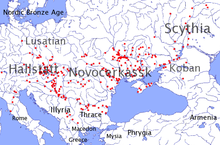Nomadic empire
Nomadic empires, sometimes also called steppe empires, Central or Inner Asian empires, were the empires erected by the bow-wielding, horse-riding, nomadic people in the Eurasian Steppe, from classical antiquity (Scythia) to the early modern era (Dzungars). They are the most prominent example of non-sedentary polities.
Some nomadic empires consolidated by establishing a capital city inside a conquered sedentary state and then exploiting the existing bureaucrats and commercial resources of that non-nomadic society. In such a scenario, the originally nomadic dynasty may become culturally assimilated to the culture of the occupied nation before it is ultimately overthrown.[1] Ibn Khaldun (1332–1406) described a similar cycle on a smaller scale in 1377 in his Asabiyyah theory.
Historians of the early medieval period may refer to these polities as "khanates" (after khan, the title of their rulers). After the Mongol conquests of the 13th century the term orda ("horde") also came into use — as in "Golden Horde".
Background[]
China relied on horses to resist nomadic incursions into its territories, but was only able to purchase the needed horses from the nomads. Trading in horses actually gave these nomadic groups the means to acquire goods by commercial means and reduced the number of attacks and raids into Chinese territories.
Nomads were generally unable to hold onto conquered territories for long without reducing the size of their cavalry forces because of the limitations of pasture in a settled lifestyle. Therefore, settled civilizations usually became reliant on nomadic ones to provide the supply of horses as needed—because they did not have resources to maintain these numbers of horses themselves.[2]
Camel-oriented Bedouin societies in Arabia have functioned as desert-based analogues of Central-Asian horse-oriented nomadic empires.[3]
Ancient history[]
Cimmeria[]

The Cimmerians were an ancient Indo-European people living north of the Caucasus and the Sea of Azov as early as 1300 BCE until they were driven southward by the Scythians into Anatolia during the 8th century BCE. Linguistically they are usually regarded as Iranian, or possibly Thracian with an Iranian ruling class.
- The Pontic–Caspian steppe: southern Russia and Ukraine until 7th century BCE.
- The northern Caucasus area, including Georgia and modern day Azerbaijan
- Central, East and North Anatolia 714–626 BCE.
Scythia[]

Scythia (/ˈsɪθiə/; Ancient Greek: Σκυθική) was a region of Central Eurasia in classical antiquity, occupied by the Eastern Iranian Scythians,[4][5][6] encompassing parts of Eastern Europe east of the Vistula River and Central Asia, with the eastern edges of the region vaguely defined by the Greeks.[citation needed] The Ancient Greeks gave the name Scythia (or Great Scythia) to all the lands north-east of Europe and the northern coast of the Black Sea.[7] The Scythians—the Greeks' name for this initially nomadic people—inhabited Scythia from at least the 11th century BCE to the 2nd century CE.[8]
Sarmatia[]
The Sarmatians (Latin: Sarmatæ or Sauromatæ; Ancient Greek: Σαρμάται, Σαυρομάται) were a large confederation[9] of Iranian people during classical antiquity,[10][11] flourishing from about the 6th century BCE to the 4th century CE.[12] They spoke Scythian, an Indo-European language from the Eastern Iranian family. According to authors Arrowsmith, Fellowes and Graves Hansard in their book A Grammar of Ancient Geography published in 1832, Sarmatia had two parts, Sarmatia Europea [13] and Sarmatia Asiatica [14] covering a combined area of 503,000 sq mi or 1,302,764 km2. Sarmatians were basically Scythian veterans (Saka, Iazyges, Skolotoi, Parthians...) returning to the Pontic–Caspian steppe after the siege of Nineveh. Many noble families of Polish Szlachta claimed a direct descent from Sarmatians as a part of Sarmatism.
Xiongnu[]

The Xiongnu were a confederation of nomadic tribes from Central Asia with a ruling class of unknown origin and other subjugated tribes. They lived on the Mongolian Plateau between the 3rd century BCE and the 460s CE, their territories including modern day Mongolia, southern Siberia, western Manchuria, and the modern Chinese provinces of Inner Mongolia, Gansu, and Xinjiang. The Xiongnu was the first unified empire of nomadic peoples. Relations between early Chinese dynasties and the Xiongnu were complicated and included military conflict, exchanges of tribute and trade, and marriage treaties. When Emperor Qin Shihuang drove them away from the south of the Yellow River, he built the famous Great Wall to prevent the Xiongnu from coming back.
Kushan Empire[]

The Kushan Empire (Bactrian: Κυϸανο, Kushano; Sanskrit: कुषाण राजवंश Kuṣāṇ Rājavaṃśa, BHS: Guṣāṇa-vaṃśa; Parthian: